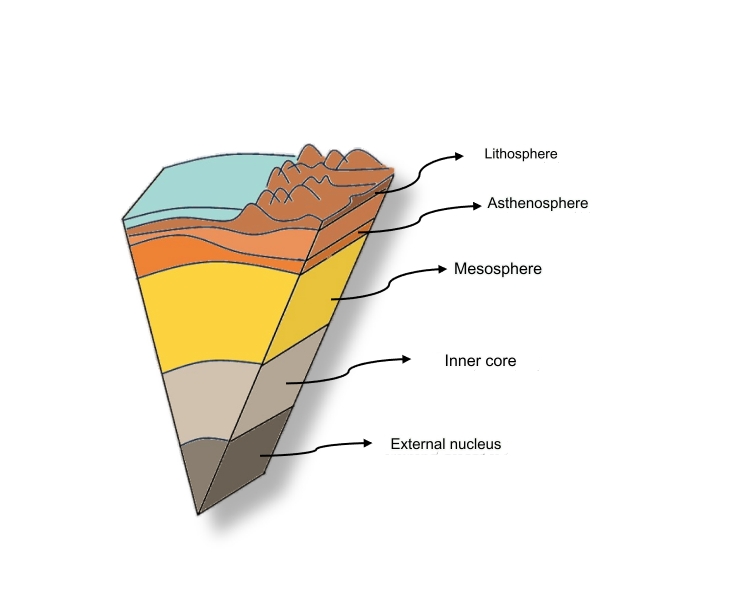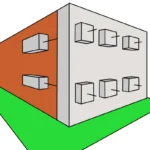What is it?
It is a branch of geology that focuses on the study of processes and phenomena causing changes in Earth’s lithosphere, i.e., the solid and rigid layer of the Earth’s surface that includes the continental and oceanic crust. This discipline seeks to understand how and why Earth changes over geological time, including the formation of mountains, earthquakes, volcanic activity, tectonic plate movement, and other significant geological events.
Geodynamics relies on observation, the collection of geological and geophysical data, as well as the application of principles of physics and chemistry to explain processes occurring inside and on the surface of the Earth. Two types of geodynamics can be identified: external geodynamics and internal geodynamics.
External Geodynamics
External geodynamics encompasses geological processes operating on the Earth’s surface, causing changes to it (changes in topography).

These processes can be mechanical, chemical, or biological, involving the transformation and transport of geological materials. External geodynamics manifests in the following cases:
Weathering
It is the natural process by which Earth’s rocks and minerals gradually break down and wear away due to exposure to the atmosphere, water, temperature changes, and other environmental factors. Weathering is fundamental in geology and landscape formation, contributing to soil creation, mountain erosion, and modification of the Earth’s surface over time.
There are two types of weathering:
Physical weathering: This type involves the decomposition of rocks and minerals without altering their chemical composition. Instead of breaking chemical bonds in minerals, physical weathering fractures rocks into smaller pieces without changing their chemical composition. Major processes of physical weathering include:
Frost action: occurs when water enters rocks and freezes, generating pressure that causes fragmentation.
Thermal fracturing: is related to daily temperature changes, as they cause rocks to expand and contract, leading to the formation of cracks and detachments.
Biological: Some living organisms, like trees with their roots, can physically break rocks.
Haloclastism: occurs in marine environments when water occupying rock pores and fissures evaporates, leaving behind salt. When it crystallizes, it increases in size, creating pressure and thus rock fragmentation.
Wind action: is when the rock surface wears away, causing erosion, predominantly in desert areas.
Chemical weathering: This type involves changes in the chemical composition of rocks and minerals due to chemical reactions with water and gases in the atmosphere. Major processes of chemical weathering include:
Hydrolysis: is when water reacts with minerals in rocks, dissolving or chemically decomposing them.
Oxidation: Some minerals react with atmospheric oxygen, causing a change in their chemical composition.
Dissolution: occurs when soluble minerals dissolve in water, leading to rock decomposition.
Carbonation: Dissolved carbon dioxide in water forms carbonic acid, which can react with minerals like calcium and magnesium.
Importance of External Geodynamics
The study of external geodynamics, focusing on geological and geographical processes affecting Earth’s surface, stands out for the following reasons:
Landscape formation: Helps understand how geographical features like mountains, valleys, canyons, beaches, and rivers form and modify.
Climatology: External geodynamics influences climate through processes like erosion, evaporation, and the reflectivity of the Earth’s surface, impacting regional and global climates.
Natural resources: Contributes to identifying and managing natural resources such as fertile soils, freshwater, and valuable geological materials, including minerals and fossil fuels.
Biodiversity impact: Changes in the landscape caused by external geodynamics can significantly impact the distribution of flora and fauna, crucial for conservation and ecology.
Natural hazards: Understanding external geodynamics allows the assessment and prevention of natural hazards like landslides, floods, avalanches, and coastal erosion, crucial for public safety.
Urban planning and land use: Essential for city planning, infrastructure, and sustainable development, as it helps understand the geological limitations and challenges of a region.
Planetary geology: Understanding external geodynamics on Earth can be applied to the study of other planetary and lunar bodies, relevant for space exploration.
Internal Geodynamics
It is a branch of geology focusing on the study of processes and phenomena occurring inside the Earth.

This discipline aims to understand how internal geological features of the planet, such as mountain formation, volcanic activity, mantle convection, internal heat generation, and tectonic plate dynamics, are generated and evolve. In this type of dynamics, we find:
Plate Tectonics: Plate tectonics is a central concept in internal geodynamics. It is based on the idea that the Earth’s lithosphere is divided into plates floating on the semi-liquid mantle. These plates move slowly and can converge, diverge, or slide laterally with respect to each other. Interactions between these tectonic plates are responsible for the formation of mountains, ocean trenches, earthquakes, and volcanoes.
Earth’s Mantle: The mantle is the layer beneath the lithosphere, extending to a depth of approximately 2,900 kilometers. Mantle convection is one of the primary drivers of plate tectonics. Heat generated in the Earth’s core rises through the mantle, creating convection currents that drive the movement of tectonic plates on the surface.
Internal Heat of the Earth: Internal heat of the Earth is mainly generated by the decay of radioactive elements in the Earth’s core. This heat source propels convection in the mantle and contributes to the process of geological differentiation, resulting in the formation of the Earth’s crust and the creation of internal geodynamics.
Volcanic Activity: Internal geodynamics is also related to the study of volcanoes and their activity. Volcanoes are openings in the Earth’s crust through which magma, molten rock, ascends from the mantle to the surface. Studying volcanic activity is essential for understanding the release of gases and volcanic materials into the atmosphere and their impact on climate and geology.
Earthquakes: Earthquakes are seismic phenomena caused by the release of accumulated energy due to the movement of tectonic plates. Internal geodynamics includes the study of geological faults and deformations of the Earth’s crust that trigger earthquakes. Understanding these processes is essential for predicting and mitigating seismic risks.
Importance of Studying Internal Geodynamics
Studying internal geodynamics is of great importance in geology and understanding Earth for several reasons, some of which are:
Understanding the internal structure of the Earth: Internal geodynamics allows us to understand how the Earth is structured internally, including the composition of internal layers such as the core, mantle, and crust, and how they interact with each other.
Explaining geological activity: Internal geodynamics is fundamental to explaining geological phenomena such as earthquakes, volcanoes, and mountain formation.
Predicting and mitigating natural hazards: Understanding how internal forces of the Earth work helps predict and mitigate geological risks. This is essential for the safety of communities that may be affected by earthquakes, volcanic eruptions, or landslides.
Natural resources and landscape formation: Internal geodynamics also influences landscape formation and the distribution of natural resources such as minerals and fossil fuels. Understanding these processes is crucial for resource exploration and management.
Long-term Earth evolution: The study of internal geodynamics contributes to our understanding of how Earth has evolved over millions of years. This includes the formation of continents, oceans, and the history of life on our planet.
Conclusion
In conclusion, the comprehensive study of geodynamics, encompassing both its internal and external aspects, reveals a detailed panorama of the processes shaping Earth. Internal geodynamics, with its focus on phenomena such as plate tectonics and seismic activity, not only deepens our understanding of geology but also plays a crucial role in predicting and managing natural disasters. On the other hand, external geodynamics, by exploring surface processes such as erosion and sedimentation, is essential for understanding the evolution of landscapes and ecosystems, with practical applications in land use planning and environmental conservation.
Therefore, the study of these sciences is important for understanding the Earth we live on, why natural disasters occur, and what the objectives or causes of soil changes and their various forms are.







Related
What Is Soil Moisture?
Importance of Slope Stability in Engineering
Tectonic Faults in Colombia and Their Impact on Civil Engineering